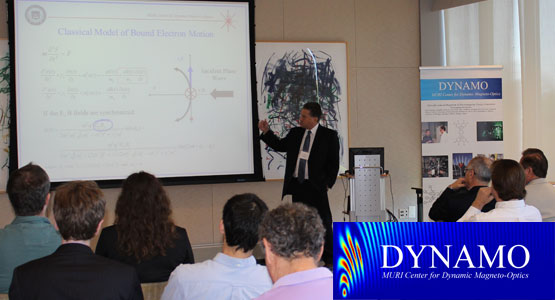DYNAMO achieves first observation of the “charge separation effect”
Research led by Prof. Stephen Rand, Director of the Center for Dynamic Magneto-optics (DYNAMO), has important potential for energy conversion, ultrafast switching, nanophotonics, and nonlinear optics.

 Enlarge
Enlarge
The University of Michigan has successfully demonstrated the “charge separation effect,” predicted over a decade ago, which has important potential for direct conversion of light to electricity without the thermodynamic losses typical of photovoltaic (solar cell) technology. The results are expected to be important to future developments in ultrafast switching, nanophotonics, and nonlinear optics as well.
“For over 150 years since Maxwell’s equations were first formulated no one has thought that effects enabled by the magnetic force of light were possible at low intensities,” says Prof. Stephen Rand, Director of the Center for Dynamic Magneto-optics (DYNAMO), who led the multi-institution team that contributed to this research.
According to Rand, the new research does not contradict Maxwell’s equations, but it does rely on a different set of assumptions than the traditional arguments regarding magnetic effects that are based on mobile charges.
“In conductive media, at relativistic intensities, the electric and magnetic components of the optical field become so strong that they start moving the charges at the speed of light and deflect the motion to cause magnetic effects,” Rand says. “But we wondered what would happen if you set the conduction current equal to zero, stopping the actual flow of charges? The result we found was totally different from historical arguments, showing that magnetism could be as large as the electric response in the presence of weak driving fields at very high frequencies.”
The resulting magnetic effects in insulators generated by low-intensity light are one million times stronger than previously expected. Under these circumstances, the magnetic force of light develops a strength equivalent to the (usually dominant) electric force of light. This suggests that magneto-electric interactions could support the direct conversion of sunlight to electrical energy, leading to a new kind of solar power source without semiconductors and without absorption to produce charge separation. This could help revolutionize the development of clean energy because theoretically the process could be over 95% efficient, and it’s particularly relevant for the space industry.
“This could be a tremendously useful energy conversion technique in space, because it doesn’t require deploying kilometer-sized solar arrays that are susceptible to distortion under thermal loading and the process itself produces negligible heat. The charge separation effect is a nonlinear response found in all-natural optical materials which responds equally well to coherent or incoherent light and avoids the generation of waste heat,” Rand says. “This could help revive deep space missions or stations on Mars that are running out of power and could be re-energized from an orbiting spacecraft. Imagine being able to transmit energy in a pinpoint beam to a specific point and then use an optical capacitor to convert the light efficiently to charge separation and stored energy.”
Imagine being able to transmit energy in a pinpoint beam to a specific point and then use an optical capacitor to convert the light efficiently to charge separation and stored energy.
Prof. Stephen Rand
The research, “Observation of magneto-electric rectification at non-relativistic intensities,” was published in Nature Communications. Applied Physics PhD student Greg Smail, who recently received the first Gérard Mourou Fellowship at U-M, is currently working on a National Science Foundation (NSF) funded extension of DYNAMO research, which will demonstrate the first ultrafast magneto-electric switch for light.
This research, supported by a five-year, $7.5M Multi-University Research Initiative (MURI) and a $1.5M equipment grant, involved researchers from Northwestern University, Stanford, RIKEN (Japan) and the University of Central Florida. It was funded by the Air Force Office of Scientific Research, the Defense University Research Instrumentation Program, and the NSF.
 MENU
MENU 
